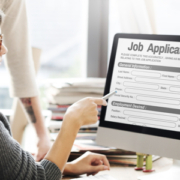How To Weigh The Risks Of Your Next Career Move
 “The Great Resignation” has been circling headlines for months as employers look to fill open positions post-pandemic, and employees look for greener pastures with a career move. The job hunt is increasingly competitive as 44% of employees are actively looking for new roles and 53% are open to leaving their current job.
“The Great Resignation” has been circling headlines for months as employers look to fill open positions post-pandemic, and employees look for greener pastures with a career move. The job hunt is increasingly competitive as 44% of employees are actively looking for new roles and 53% are open to leaving their current job.
The good news is that there’s no shortage of open positions. As of January 2022, the U.S. had 11.26 million jobs available — a 55% increase from January of 2021. The pressure to hire has encouraged employers to consider increased pay, benefits, and flexibility at work.
Diving into a new job presents plenty of opportunities to develop your career, skills, and financial wellness. It can also be intimidating to learn new processes, develop new relationships, and potentially find yourself in a less-than-ideal working environment.
After refining your resume, applying to positions daily, and attending a few interviews, you may finally find yourself presented with a job offer. A gleaming opportunity that may offer higher pay or a more prestigious job title, but you can’t be sure of its work-life balance or career challenges yet.
Some well-deserving workers may even receive multiple offers to consider. These situations create pressure to make a decision relatively quickly. It’s a good spot to be in, but having the skills to evaluate risk and rewards lets you fully enjoy the moment and guides you to make a confident decision.
If you’re in the middle of a job hunt or considering other career opportunities, here are some steps to help you weigh the options.
1. Identify Your Priorities
Your individual needs for your next career move are unique to you, and understanding those goals helps you create a framework for comparing offers. A majority of workers (56%) are looking for a pay raise, but there are several job benefits to consider, including:
- Health benefits
- Job security
- Flexibility at work
- Career goals
- Employer culture
Take time to list the potential benefits of a new job and rank what’s most important to you. This is a great practice before you start applying so you can save your time and energy for positions that best fit your needs. It can also help you decide how well your current position matches your needs to consider if you’re ready for a change or not.
Next, make a spreadsheet or other list that includes all of these benefits and rank how well each job opportunity meets these criteria. This creates an easy and objective reference to compare jobs that you can update to reflect your needs as they evolve.
2. Research The Position
The internet age has given us a range of resources to evaluate employers and job expectations that too many employees don’t take advantage of. While you likely studied a company, its values, and the position itself throughout the interview process, another review before signing on is worth your time.
Start with the company itself and explore its communication channels. YouTube videos, press releases, and the About page can help you identify cultural values, how the company has and continues to grow, and insights into management. Some companies even go as far as to share their hiring secrets — a great reference in the interview phase.
Review sites like Glassdoor provide a peek into the employee experience through position and interview reviews. Check out the site to vet your priorities against what other employees report their experience with the company was. You’ll also have access to salary ranges that will help you negotiate your pay.
Finally, you’ll get the best information straight from current and former employees. Check out the company’s LinkedIn page to find current employees and search the company name to find anyone who previously worked there. You can connect with workers and send a quick chat that you’d like to know more about their experiences. You may be surprised to find how willing people are to help you find a job that fits.
3. List Your Risks
Most people stuck between two options are worried about making the wrong decision more than they are making the best decision. They’re hung up on the risks, wondering if it’s a step backward or if they’re really cut out for the position.
Imposter syndrome aside, it’s important to consider the risks of a new position. To compare the risks of staying and leaving, you need to start by identifying them. Sit with the moment and feel your excitement, fear, hesitation, and joy. What’s the root of each of these feelings? You may think:
- “There’s no room to grow in my current position.”
- “What if I don’t work well with my new manager?”
- “If this career change doesn’t work out, I may have to restart where I am now.”
- “If this startup goes under, I have to job hunt again.”
List these risks under the decision it ties to. Visually seeing the number of risks for each choice is helpful, but not all risks are equal. Place the biggest risks at the top of each list and continue the list from most to least risky.
4. Evaluate And Control Risk
Now that you have clear lists of your potential risks and rewards, go back and consider how you can negate some of the risks. Here are some examples from the previous exercise:
- If there’s no room to grow in your current position, is there a new skill you can develop to open higher career opportunities?
- If you’re worried about your next manager, can you set up a meet and greet through the employer?
This practice can also uncover that the risks aren’t holding you back so much as a fear of change. That’s absolutely natural. Especially considering the economic turbulence of the last two years. Still, 80% of employees that quit their job in the last two years have no regrets.
5. Make The Decision That’s Right For You
Changing jobs is an excellent way to advance your career and financial health. Salaries increase an average 14.8% with a new role — especially if you’re early in your career. On the other hand, you’re placed in a new environment to develop new working relationships, which comes with its own networking benefits.
Ultimately, there’s probably not a right or wrong answer. No matter what you choose, you have the option to continue looking for new opportunities if you don’t love where you land. If you land in a position that helps you thrive, that’s a huge win for your well-being and career.
Following the steps above can give you peace of mind that you’re making the best choice with the information available to you. But remember that your next job is far from the end of the line, and there’s always another opportunity around the corner.
By: Bri Marvell is a content creator from Austin with interests in financial wellness and career development. When she’s not at her desk, you can find her exploring the city with her dog, Miko, or getting creative with a new craft.









